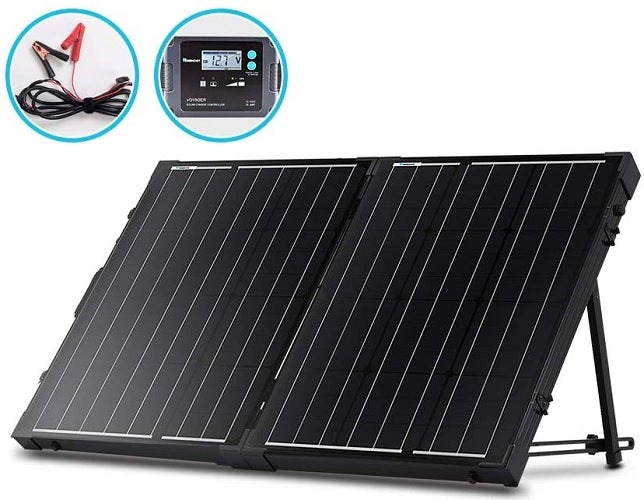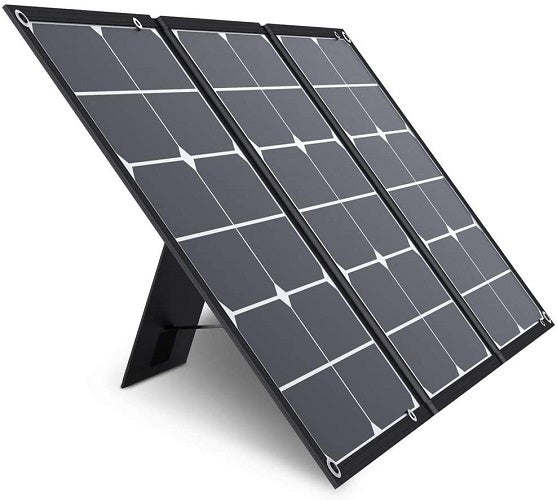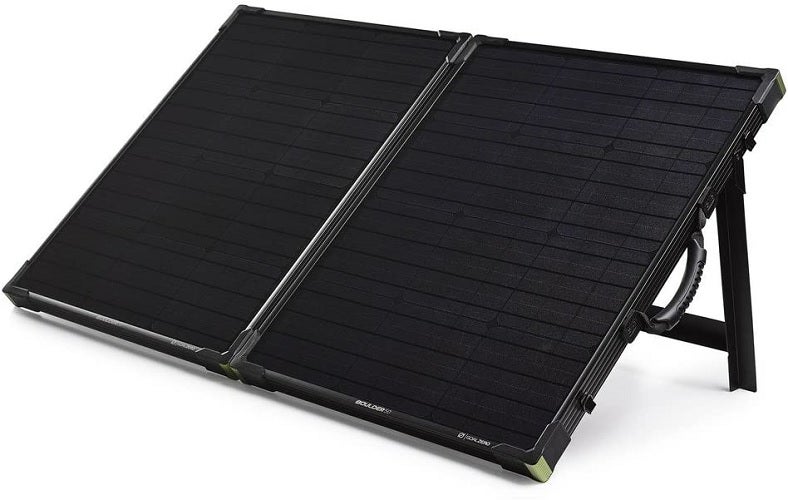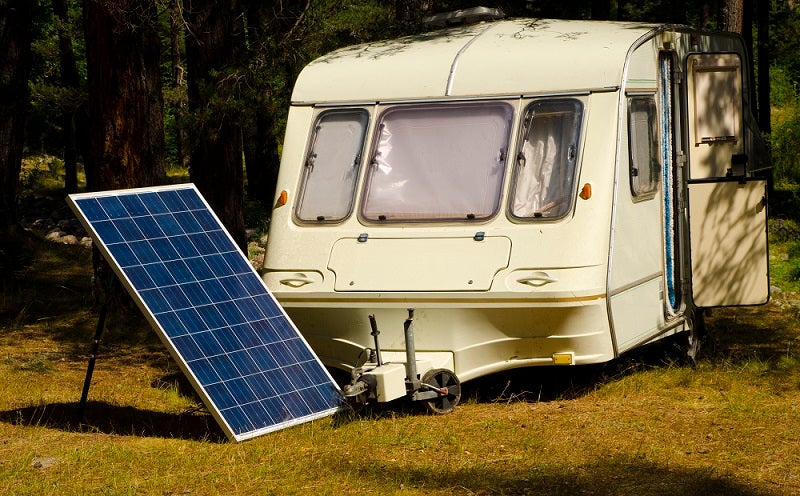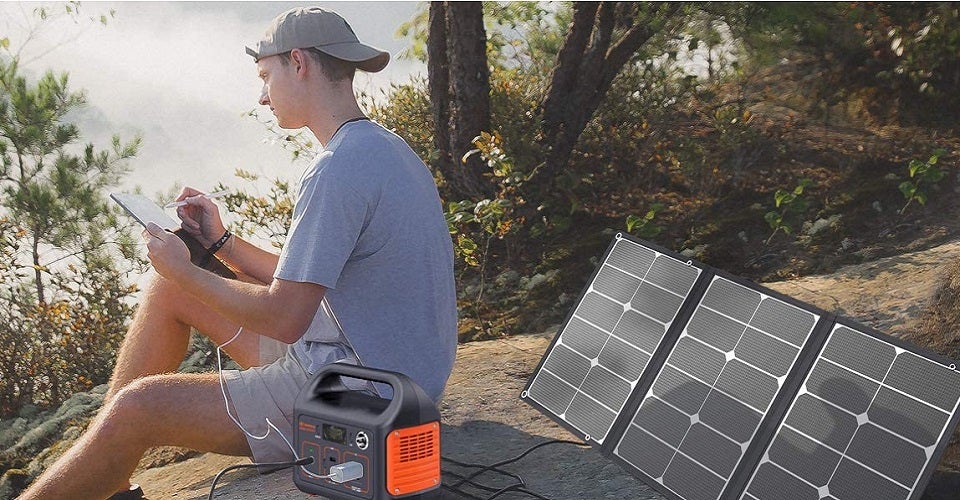
Our Editors independently research, test, and rate what we feel are the best products. We use affiliate links and may receive a small commission on purchases.
As our world becomes ever more connected and energized portable power becomes increasingly important. Portable solar panels are one solution to power on the go.
The best portable solar panels for camping today easily outperform those from even a few years ago. Advances in technology and efficiency mean that portable solar panels should be on your radar now.
Choosing the right portable solar panel for your outdoor needs isn’t always as simple as we might like. In this article, we’ll go over everything you need to know to choose the top portable solar panels for you.
I’ll help you learn what to look for and what to avoid so join me as we learn about portable solar tech!
Best Portable Solar Panels
For more of my top camping gear recommendations, have a look through these popular Outside Pursuits guide links: Portable Power Stations, Power Inverters, Deep Cycle Batteries.
Quick Answer: The Best Rated Portable Solar Panels
- Renogy Off Grid Portable Foldable Solar Panel
- Jackery SolarSaga Portable Foldable Solar Panel
- Rockpals Foldable Solar Panel Charger
- Goal Zero Boulder Briefcase Solar Panel
- TP-Solar Portable Foldable Solar Panel Charger Kit
- TISHI HERY 120W Portable Solar Panel
- ROCKPALS Portable Solar Panel Charger
Our reviews of the top rated portable solar panels along with our comparison table and buyers guide will help you choose the right one for you.
Portable Solar Panel Reviews
#1 Renogy Off Grid Portable Foldable Solar Panel
- Power Output: 100W 8.3A
- Size: 1,082 sq in
- Size Folded: 20” x 27.2”
- Weight: 25.6 Pounds
- Connectors: MC4, alligator clips
Let’s get started with something that can fit the bill for most users. This foldable, solid-panel mono solar charger is ready to work with most 12v systems right out of the box.
Out of the box, this panel comes with a waterproof power management unit. It’s rated for 20A and has a built-in 4-stage battery charging controller. It’s made specifically to use the included alligator clips to charge any 12V battery.
While the open circuit voltage is rated at 21.6V, the power unit output is regulated at 12V.
It does come with a protective case and folds in half to a smaller size. That said, it’s still pretty heavy so you’ll want to use this for car or truck camping.
If you are looking for the best portable solar panels for plug and play use when you want to charge a standard 12V battery with alligator clips, the Renology is your best bet.
#2 Jackery SolarSaga Portable Foldable Solar Panel
- Power Output: 60W 3.3A
- Size: 17.5″ x 36″
- Size Folded: 17.5″ x 12″
- Weight: 3.3 Pounds
- Connectors: USB-C, USB-A, Anderson connector
Ideal for pairing with other Jackery portable power stations, this panel can also act as a standalone charger. It’s lightweight, affordable, and simple to use.
Since the Jackery portable power stations make such a good pairing we’ve included this panel on our list. It has built-in USB connectors right on the panel. That makes it a great choice for those who want to use just a USB-C or USB-A without a piggyback battery.
If you want to connect to other panels, however, you may need an adapter. This panel uses an Anderson style connector to plug into the Jackery power station inputs.
These panels fold in on themselves and include a built-in carrying handle. There’s also a nice zippered pouch on the back to keep all the related cables organized.
Best for pairing with the popular Jackery brand portable power products. You can also save a few dollars buy getting the combo power station and panels.
#3 Rockpals Foldable Solar Panel Charger
- Power Output: 100W 5.4A
- Size: 20.5 x 56.8”
- Size Folded: 20.5″ x 14.2”
- Weight: 10.8 Pounds
- Connectors: 2x USB, 1x USB-QC, MC4
Versatile, affordable, and effective this solar panel is a hard option to turn down. It makes perfect addition to the Rockpals Power Station but if you want to be able to plug into practically anything, check this out.
One of the nicest features of this solar panel is the integrated USB charger. It has 3 ports and two of them are standard USB while the third is a rapid-charger QC USB output.
The integrated digital controller automatically identifies and adjusts power output for the best charge on your device.
Additionally, they’ve included about every possible DC power connector you can think of. Plug in the MC4 cable and then use one of the 10 different adapters provided to find the right connection to your device.
The Rockpal is the best solar panel for camping for pairing up with any DC-compatible portable power station regardless of brand
#4 Goal Zero Boulder Briefcase Solar Panel
- Power Output: 100W 7A
- Size: 40″ x 27”
- Size Folded: 20 x 27”
- Weight: 25 Pounds
- Connectors: 8mm
Rigid, durable, and made to last this folding solar panel is a great choice for car, RV or truck camping. This panel is a perfect addition to the Goal Zero Yeti Power Station.
One of my favorite features of this solar panel is the rigid frame. It comes with two adjustable legs that fold away for storage.
When you deploy them you can use the thumb screws to set the angle you want on the solar panel to help maximize sun exposure.
This panel can be chained together with other Goal Zero panels to increase your charging power. It will work with any standard 12V battery which can then be used to power or charge whatever you want.
With a weatherproof design and included carry case, the Goal Zero is easy to take anywhere you need off grid power.
#5 TP-Solar Portable Foldable Solar Panel Charger Kit
- Power Output: 60W 3A
- Size: 22.8 x 25.6”
- Size Folded: 11.4″ x 6.2”
- Weight: 3.1 Pounds
- Connectors: 2x USB, alligator clips, car accessory port, DC
Want a solar panel you can use to charge practically anything? One of the best features of this foldable solar panel is the sheer number of ways you can charge!
Lightweight? Check. Versatile? Check.
This folding solar panel can be used to charge pretty much anything you can think of. With 10 different DC plugs, car charger, alligator clips, and built-in USB QC ports it’s got everything.
Rated at 60W, however, the panel may not be able to keep pace with some of the other more advanced panels on our list. That’s okay though, because not everyone needs a fast charge.
The TP-Solar’s are the best portable solar panels for camping if you are on a budget.
#6 TISHI HERY 120W Portable Solar Panel
- Power Output: 120W 18V/6.7A
- Size: 64.5″ x 20.2”
- Size Folded: 14″ x 20.2”
- Weight: 8.8 Pounds
- Connectors: USB, alligator clips, DC out, QC3.0, Type-C
Made from many small panels, this folding solar panel collapses down into a relatively small package for easy storage and transport.
Like many of the panels on our list this one sports 10 different DC output adapters. It also includes alligator clips and a cable, a 78-inch long Anderson and MC4 cable, a rag and two carabiners.
What’s great about this device is that it can simultaneously charge four devices thanks to the versatile charging port.
Overall, however, it’s not one of the smallest or lightest panels on our list. At just under 9 pounds it folds up into its own carrying case for easy transport.
Best for those who want a versatile panel to charge multiple devices.
#7 ROCKPALS Portable Solar Panel Charger
- Power Output: 60W 6A
- Size: 58.2″ x 13.8”
- Size Folded: 13.3″ x 13.8”
- Weight: 5.6 Pounds
- Connectors: 2x USB2.0, 1x QC3.0, DC out
Whether you want to hang it or prop it up, the foldable ROCKPALS 60W is a good middleground choice. It’s more portable than the larger models and more powerful than the compact models.
Right off the bat I want to point out the best feature of this panel. It’s plug-and-play ready to parallel charge with a second one. If you buy two you can use the DC cable to plug the two together and double the output. Really cool feature.
It also comes with 10 different DC output plug types that will cover most applications.
It can be left freestanding with the included adjustable kickstands, or you can hang it to charge.
Probably the best portable solar panels for RVs that are easy to parallel connect to increase power output.
Portable Solar Panel Comparison Table
| Portable Solar Panel | Output | Unfolded Size | Size Folded | Weight | Rating | |
|---|---|---|---|---|---|---|
| Renogy Off Grid Solar Panel | 100W 8.3A | 1,082 sq in | 20” x 27.2” | 25.6 lbs | 4.5 / 5.0 | |
| Jackery SolarSaga Solar Panel | 60W 3.3A | 17.5" x 36" | 17.5" x 12" | 3.3 lbs | 4.7 / 5.0 | |
| Rockpals Solar Panel | 100W 5.4A | 20.5" x 57” | 20.5" x 14.2” | 10.8 lbs | 4.7 / 5.0 | |
| Goal Zero Boulder Briefcase Solar Panel | 100W 7A | 40" x 27” | 20 x 27” | 25 Pounds | 4.6 / 5.0 | |
| TP-Solar Solar Panel Charger Kit | 60W 3A | 23" x 25.6” | 11.4" x 6.2” | 3.1 lbs | 4.6 / 5.0 | |
| TISHI HERY 120W Portable Solar Panel | 120W 6.7A | 64.5" x 20.2” | 14" x 20.2” | 8.8 lbs | 4.6 / 5.0 | |
| ROCKPALS Solar Panel Charger | 60W 6A | 58.2" x 13.8” | 13.3" x 13.8” | 5.6 lbs | 4.6 / 5.0 |
How to Choose the Best Portable Solar Panels for You
Charging Power
Power, as it’s measured in scientific terms, uses “watts” as the standard unit in this application. Solar panels will be rated for certain power output and that rating will be displayed in watts.
For instance, a solar panel might say “30 Watts”. This is the maximum rated output if everything is perfect. Now keep in mind that the power a solar panel can generate is greatly affected by environmental factors you may or may not have control over.
How quickly a solar panel can charge or power a device will be directly related to its power output. A 100 W solar panel will charge substantially faster than a 20 W solar panel.
Charging power can often be increased by linking solar panels. If you link a 20 W and a 40 W panel you’ll have 60 W of total maximum output.
Solar Panel Plugs & Cables
Luckily solar panels have mostly been standardized to universal plug and cable types. This makes it much easier to buy a panel from brand A and plug it into a batter from brand B. That said, some companies still make and sell proprietary equipment so keep an eye out for that.
MC4 adapters are the standard plug option for the vast majority of solar charging applications. While there are many different connectors and cables out there, sticking with the MC4 cables and using a portable power station already equipped to be charged from a solar panel will be the easiest least painful method of charging.
Solar Panel Size
To find the best solar panels for camping, we have to consider more than just their raw electrical specifications. You may have the best solar panel in the world, but if it won’t fit in your car, truck, or camper then it’s not right for your needs.
Of course, the surface area of a solar panel directly correlates to its power generating capacity. For that reason, choosing a portable solar panel that is as large as possible while still reasonable for your needs is ideal.
When it comes to hikers and backpackers, however, space is at a premium. You’ll want to really consider weight and size when choosing an ultra-portable model.
Most portable solar panel users are camping from cars, trucks, and RVs. In these cases, the size of your solar panel should be based on your power consumption needs, as well as the maximum space you have to store and transport since weight is not an issue.
Panel Setup & Adjustment
Because the angle of your solar panel into the oncoming sunlight is so critical to generating maximum power, a good support stand is crucial. Simply laying a flat solar panel on the ground won’t do nearly as much good as setting it up to match the angle of the sun.
When you go to pick out a portable solar panel, consider how it will set up. Does it have a stand with adjustable legs? Does it hang from a tree?
To get the most out of your solar panel you really need one that can be adjusted easily. Look for adjustable legs or supports that allow you to easily get the correct angle no matter where you set up.
Before making a final decision, think through how you will set up and adjust your solar panel on your RV, on the ground, or on whatever support structure you plan to use to get the right angle.
Output Current
Current is a measurement of electricity separate from power. While power is measured in Watts, the current is measured in Amps. Amperage can be calculated by dividing outputt Watts by output Volts.
Why does this matter? Because some devices can only be charged if a minimum output current is achieved.
Remember that we said solar panel efficiency can be dramatically affected by sun and environmental factors? Well, since output current is a direct result of how much sun your solar panel can get ahold of, that means how you set up (and the weather) have a direct impact on your output current at any given moment.
What it boils down to is that, without some type of control device, the output of your solar panel current can vary quite dramatically.
This is one reason why charge control units are popular. Additionally, most solar panels are designed to charge a compatible (sometimes integrated) battery which then can be used to charge other devices.
Charge Controllers
Since the output of your solar panel can change pretty dramatically from moment to moment, it’s critical to control the flow coming out. You don’t want your iPhone plugged directly into a fluctuating power source as that can quickly cause issues.
In order to solve this problem, most solar panels operate best when paired with a control unit of some kind. To keep things easy, it’s ideal to have a solar panel with an integrated or associated charge control unit that is “plug and play” ready.
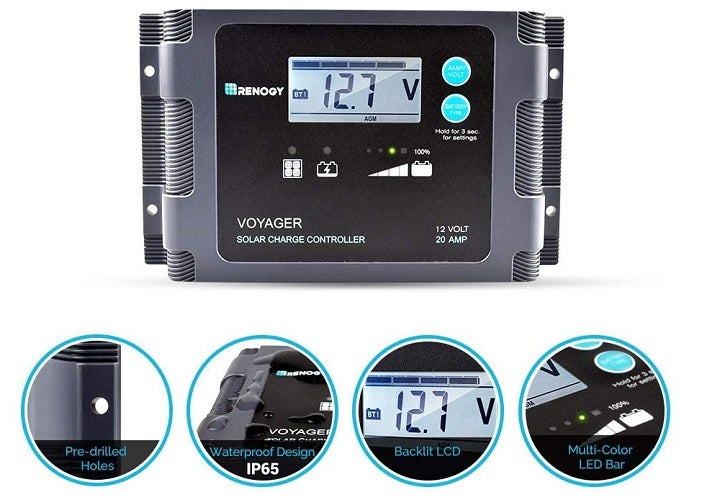
Types of Solar Panels
In the modern world of portable solar panels, there are essentially three different types.
Monocrystalline solar panels are rigid and efficient. These panels have the best durability and efficiency overall for the average consumer.
Polycrystalline solar panels are a little less efficient than the mono versions. They’re cheaper to produce, however, so on large-scale operations poly panels can sometimes have advantages.
CIGS or flexible solar panels are made from a mashup of metals. These panels are made from a thin flexible film that can be folded, rolled, or otherwise manipulated instead of rigid panels. Because of the use of flexible materials, however, these panels are prone to delamination and have a shorter lifespan than most monocrystalline panels.
For car camping, RVing, and general off-grid power a monocrystalline panel is by far the most common, and most sensible option. When we start talking about backpacking weight and bulk become serious considerations.
Flexible solar panels can make sense for backpacking but probably won’t be a great choice for other applications due to their loss of durability and efficiency compared to mono.
FAQs About Portable Solar Panels
Q: How do I maximize the output of my solar panel?
A: Solar panel power output is controlled by a handful of factors.
Sunlight is, of course, the most important. Direct access to unobstructed sunlight is critical. Solar panels work best outdoors with no glass between them and the sun. Sunny days are better than cloudy or overcast days.
The angle of incidence refers to the angle of the sun versus the angle of your solar panel. Ideally, at any given moment your solar panel should be aligned facing directly at the sun wherever it is in its path. Laying a solar panel flat on the ground will produce less power than angling it toward the exact direction of the sun itself.
Keeping it clean will help your solar panel produce maximum output. Scratches, smudges, fingerprints, oil, and dust will all rob your solar panel of power output as the block or scatter light.
Q: How much power do I really need?
A: Both the size and power output of solar panels range greatly. Solar panels come as small as a notepad or as large as a vehicle. How can we know what’s necessary for us?
Well, part of the question depends on your budget. Do you have the money to throw at a large solar panel?
Next, you’ll want to consider how much space you have to store and transport a solar panel. Think about where you’ll store your panel in your RV or how you’ll pack it into your vehicle. Folding panels or panels small enough to fit your transportation options should take priority if needed.
Last, but not least, is to consider the power output you’ll need. Can you get away with charging on a 30W panel that’s relatively small? Alternately, maybe you’re running several power-hungry devices or have a lot of people drawing power from your solar panel. You may need a larger multi-hundred-watt panel.
Q: What kind of batteries can I charge?
A: Most portable solar panels on the market today come ready to use out of the box. Many of them come with integrated power management units built-in.
These power management units then distribute a controlled flow of electricity to either a standard lead terminal battery or to a portable power station battery.
You can use the regular old alligator car-battery-style clamp chargers to charge any normal 12V battery (or a bank of them). Or, on many units, you can use the MC4 cables to plug into a portable power station that may have USB ports, wall outlet style ports, and more.
Maybe the easiest combination for most users is to combine a portable solar panel with a portable power station that’s ready to go right out of the box. No hassle!
Q: Can I charge my phone with a solar panel?
A: Yes.
Many of the portable solar panels on our list do include a built-in USB port for charging. Look for the rapid charge QC style ports. These will adapt the output current to match the needs of your phone and charge modern phones faster than a plain-ol’ USB plug.
If your solar panel doesn’t have a USB plug on it, usually you can charge a portable power station using the solar panel. These portable power stations then have USB plugs for charging your phone or other devices. Problem solved.
Q: Do I need a power inverter?
A: Power inverters change DC current (from a solar panel or battery) into AC current like what comes out of your wall at home. Before we can answer this question you need to know whether your device requires DC or AC current to charge.
Many devices that plug into the wall actually convert the AC into DC anyways so sometimes you may not need an inverter at all.
If you’re trying to charge an AC device off of a solar panel or battery you will need an inverter. You can’t just plug an inverter into a solar panel, however. Most inverters need much more power than an average portable solar panel can push out.
Instead, you’ll want a solar panel that can charge a 12V battery. Plug the solar panel into the battery for charging. Then you’ll want to plug an inverter into the battery for output. The battery acts as a buffer between the solar panel and the inverter and stores excess power until your devices need it.
Final Thoughts
There are as many portable solar panels out there as there are needs for them. Whether you want to charge a battery, plug multiple panels together for more power, or find a lightweight portable solar panel for backpacking chances are good there’s an option out there for you.
We’ve taken a look at many of the most popular portable solar panels for camping and outdoor use. These panels are much better than their predecessors. They’re faster, more efficient, and easier to use and each year our technology improves.
Without a doubt the easiest solution is to find a ready-to-use portable solar panel that will charge or power what you’re looking to use. Modifying, wiring, or adjusting batteries and solar panels is possible but requires lots of knowledge and careful planning to prevent damage or disaster.
Revisit the “how to choose” section before you make your final choice to brush up on the ins and outs of portable solar panels!

